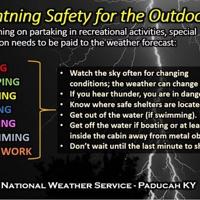Lightning strikes the United States about 25 million times a year. Although most lightning occurs in the summer, people can be struck at any time of year.
Lightning kills an average of 30 people in the United States each year, and hundreds more are severely injured. This week marks the 22nd anniversary of National Lightning Safety Week, and it is important for folks spending time outdoors to follow some advice from the National Oceanic and Atmospheric Association.
Since Oklahoma is in the heart of Thunderstorm country, we rank third nationally in lightning strikes per year, falling only behind Texas and Florida. So it is important to heed the NOAA campaign slogan – When Thunder Roars, Go Indoors.
Lightning is a dangerous weather threat. In fact, over the past 10 years, lightning has claimed the lives of 25 people per year on average, with 4 deaths already this year.
Most if not all of the victims were caught unaware of the incoming strike during leisure and work activities where their attention was diverted. Water-related activities accounted for 33% of all leisure fatalities while farming/ranching accounted for 26% of work-related fatalities.
Lightning deaths occur most frequently during the summer time months when people are outside enjoying the sun or working while the weather is good. Not only do the number of outdoor activities increase in the summer, but also the frequency of thunderstorms. During the winter months when storms are less common, lightning fatalities take a noticeable dip.
However, lightning remains a dangerous threat at all times as it only takes one strike to cause life-changing injuries.
John Jensenius, aka “Dr. Lightning” a lightning safety specialist with the National Weather Service, conducted the study by examining demographic information for 251 deaths attributed to lightning over the last ten years. NOAA released these findings on the first day of National Lightning Safety Awareness Week to call attention to the danger of outdoor activities during a thunderstorm.
Water related activities contributed to 35% of leisure-related fatalities. The water-related activities include fishing, boating, swimming, or just relaxing at a beach or lake. Sports-related activities contributed another 14%. Sports-related fatalities include soccer, golf, running, baseball, and football. Other activities that contributed to the deaths in the leisure category included camping (8%); riding bikes, motorcycles and ATVs (7%); social gatherings (7%); hiking (4%); walking (4%); relaxing outside the home (3%); tourism (2%); children’s play (2%); horseback riding (2%); and “other” (10%). The “Other” category included: hunting, building a tree house, etc.
“When people think of lightning deaths, they usually think of golf,” Jensenius said. “While every outdoor activity is dangerous when a thunderstorm is in the area, outdoor activities other than golf lead to more lightning deaths. NOAA has made a concerted effort to raise lightning awareness in the golf community since we began the campaign in 2001, and we believe our outreach has made a huge difference since lightning-related deaths on golf courses have decreased by 75 percent.”
Jensenius said the large number of fishing, camping and boating lightning deaths may occur because these activities require extra time to get to a safe place. “People often wait far too long to head to safety when a storm is approaching, and that puts them in a dangerous and potentially deadly situation,” he said.
Prior to the lightning safety campaign, lightning killed an average of 73 people each year in the United States. Since the National Weather Service launched the campaign, the average has dropped to 37. Seven people have died from lightning strikes so far this year.
There are 5 ways that lighting can strike a person:
Direct strike — A person struck directly by lightning becomes a part of the main lightning discharge channel. Most often, direct strikes occur to victims who are in open areas. Direct strikes are not as common as the other ways people are struck by lightning, but they are potentially the most deadly.
In most direct strikes, a portion of the current moves along and just over the skin surface (called flashover) and a portion of the current moves through the body–usually through the cardiovascular and/or nervous systems. The heat produced when lightning moves over the skin can produce burns, but the current moving through the body is of greatest concern. While the ability to survive any lightning strike is related to immediate medical attention, the amount of current moving through the body is also a factor.
Side flash — A side flash (also called a side splash) occurs when lightning strikes a taller object near the victim and a portion of the current jumps from taller object to the victim. In essence, the person acts as a “short circuit” for some of energy in the lightning discharge. Side flashes generally occur when the victim is within a foot or two of the object that is struck. Most often, side flash victims have taken shelter under a tree to avoid rain or hail.
Ground current — When lightning strikes a tree or other object, much of the energy travels outward from the strike in and along the ground surface. This is known as the ground current. Anyone outside near a lightning strike is potentially a victim of ground current. In addition, ground current can travels in garage floors with conductive materials. Because the ground current affects a much larger area than the other causes of lightning casualties, the ground current causes the most lightning deaths and injuries.
Ground current also kills many farm animals. Typically, the lightning enters the body at the contact point closest to the lightning strike, travels through the cardiovascular and/or nervous systems, and exits the body at the contact point farthest from the lightning. The greater the distance between contact points, the greater the potential for death or serious injury. Because large farm animals have a relatively large body-span, ground current from a nearby lightning strike is often fatal to livestock
Conduction — Lightning can travel long distances in wires or other metal surfaces. Metal does not attract lightning, but it provides a path for the lightning to follow. Most indoor lightning casualties and some outdoor casualties are due to conduction. Whether inside or outside, anyone in contact with anything connected to metal wires, plumbing, or metal surfaces that extend outside is at risk. This includes anything that plugs into an electrical outlet, water faucets and showers, corded phones, and windows and doors
Streamers — While not as common as the other types of lightning injuries, people caught in “streamers” are at risk of being killed or injured by lightning. Streamers develop as the downward-moving leader approaches the ground. Typically, only one of the streamers makes contact with the leader as it approaches the ground and provides the path for the bright return stroke; however, when the main channel discharges, so do all the other streamers in the area. If a person is part of one of these streamers, they could be killed or injured during the streamer discharge even though the lightning channel was not completed between the cloud and the upward streamer
The best way for people to protect themselves against lightning injury or death is to monitor the weather and postpone or cancel outdoor activities when thunderstorms are in the forecast. Lightning can strike from 10 miles away, so if people can hear thunder, they are in danger of being struck by lightning. The only safe places to be during a thunderstorm are in a building with four walls and a roof or in a car. A hut, cabana, tent, or other rain shelter will not protect a person from being struck by lightning.
Here are some lightning tips offered by the National Weather Service:
NO PLACE outside is safe when thunderstorms are in the area!!
If you hear thunder, lightning is close enough to strike you.
When you hear thunder, immediately move to safe shelter: a substantial building with electricity or plumbing or an enclosed, metal-topped vehicle with windows up.
Stay in safe shelter at least 30 minutes after you hear the last sound of thunder.
Stay off corded phones, computers and other electrical equipment that put you in direct contact with electricity.
Avoid plumbing, including sinks, baths and faucets.
Stay away from windows and doors, and stay off porches.
Do not lie on concrete floors, and do not lean against concrete walls.
If you are caught outside with no safe shelter anywhere nearby the following actions may reduce your risk:
Immediately get off elevated areas such as hills, mountain ridges or peaks
Never lie flat on the ground
Never shelter under an isolated tree
Never use a cliff or rocky overhang for shelter
Immediately get out and away from ponds, lakes and other bodies of water
Stay away from objects that conduct electricity (barbed wire fences, power lines, windmills, etc.)
Want to reach a local audience and grow your business?
Our website is the perfect platform to connect with engaged readers in your local area.
Whether you're looking for banner ads, sponsored content, or custom promotions, we can tailor a package to meet your needs.
Contact us today to learn more about advertising opportunities!
CONTACT US NOW






